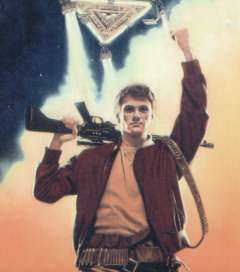

-
"Not only don't I believe in salvation by aliens, but I also doubt quite
strongly that there is anyone out there to send us SETI signals."
Harry has said many times that science fiction, to him, is not about the technology, or the alien worlds or the alien races: it's primarily about people.
But he has, of course, written about aliens: his classic short story "The Streets of Ashkelon", for example, features a planet with an indigenous, sapient alien race. Books like Invasion: Earth, the Bill, the Galactic Hero series, Planet Story and Starsmashers of the Galaxy Rangers - along with more serious works like Lifeboat and the West of Eden trilogy - feature alien races (though in the latter the aliens are not of extra-terrestrial origin).
Early in his career as a writer, Harrison realised that probably the best way to illustrate the diversity of the human race was to show how capable we are of change...
Many of Harry Harrison's earlier novels are set in the distant future, a time long after the human race has spread to the stars and all but forgotten Earth, the "homeworld".
In those novels, there are no aliens - only people descended from the original colonists. There is mention in some of the books of something called the Breakdown - a time when contact between the colonies was lost.
The Stainless Steel Rat books often refer to the Breakdown, and the subsequent gradual rediscovery of human-inhabited planets and systems, most of which have followed disparate paths of social and technological evolution. Other books showing the aftermath of the Breakdown include the Brion Brandd series, the Deathworld series, plus - arguably - Captive Universe and several short stories, notably "Final Encounter".
But the actual nature of the Breakdown wasn't revealed until the To the Stars trilogy... The first novel, Homeworld, is set on Earth hundreds of years from now. There is a great schism in the population: the rich are very rich and want for nothing, while the poor are underfed, mostly unemployed, miserable and angry. The protagonist, Jan Kulozik, is a wealthy engineer who, by accident, comes into contact with a team of spies from Israel, the only remaining democratic state.
Jan becomes involved - unwittingly at first - with the Israelis, and for the first time gets a chance to see the world through the eyes of the other side of the population.
Jan's involvement leads to his capture and imprisonment. Wheelworld opens with Jan exiled to the planet Halvmork, a world that has been terraformed for one purpose: to provide massive amounts of grain for the other planets.
Events lead Kulozik to conclude that the long-expected rising has finally happened: the outer planets have seceded from Earth's rule.
In the final novel in the trilogy, Starworld, Kulozik becomes embroiled in a devastating war to free Earth from its oppressive government. The seeds of the Breakdown are here: many of the different colonies can't agree on how they're going to fight this war.
By the end of the trilogy, it's clear that the Breakdown was a necessary step in human social evolution: the isolation of the colonies means that, no matter what happens on any one planet, the human race will still survive in one form or another.
The Disans of Planet of the Damned, the Gray Men of The Stainless Steel Rat's Revenge, the Pyrrans of Deathworld... They are all human, and they are all, to us, alien. They are different off-shoots of the ever-branching tree.
With the concept of the Breakdown, Harry Harrison has created a rich, full universe that shows us many possibly outcomes for the human race. We will go forth and multiply. Many of us will develop great societies. Many more will forget where we came from, forget who we once were...
And it all starts here, with the To the Stars trilogy.
